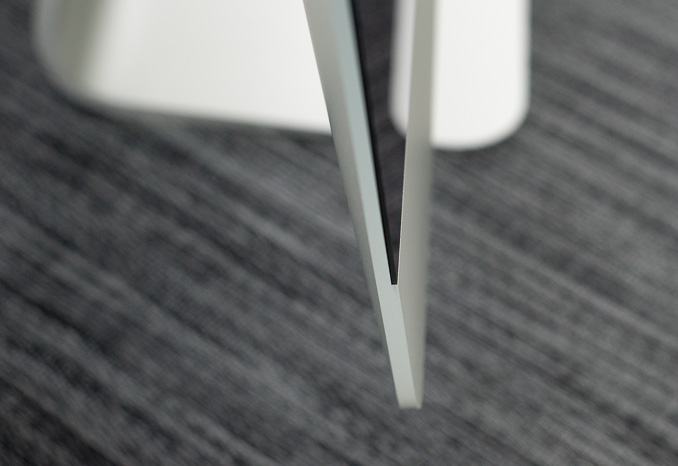21.5-inch iMac (Late 2013) Review: Iris Pro Driving an Accurate Display
by Anand Lal Shimpi on October 7, 2013 3:28 AM ESTFinal Words
Apple continues to have the strongest Mac lineup of its history. While I’m expecting something pretty cool with Broadwell next year, Apple’s Haswell Mac lineup continues to be an evolutionary improvement over the systems that were introduced last year.
The iMac’s industrial design is beautiful. I’m not sure I’m happy with the bezel thickness around the display, but otherwise I’m happy with the way Apple’s 2012 redesign turned out. Particularly with the 21.5-inch model, the compactness of the new iMac is pretty awesome. It’s a lot like the benefits of having a lightweight LCD TV - you only appreciate it when you have to move the thing, but it’s nice to have regardless of how rarely you move it.
Although I didn’t talk about this in the review, the in box wireless peripherals both work well. Combined with the fact that you can get 500Mbps file transfers over 802.11ac (over short distances, with Mavericks), you can really use the iMac with only a single cable and be pretty happy. Toss in Apple’s new 802.11ac Airport Extreme and you’ll have great wireless range as well.
The iMac’s out of box display experience is nothing short of incredible. Imaging professionals in dire need of color accuracy can walk into an Apple store, walk out with the entry-level iMac and have a remarkable experience. I’d love to see a higher resolution panel, but 4K panel pricing isn’t quite low enough yet (not to mention the possibility of Apple wanting to go 5K on its 27-inch display).
I wouldn’t touch either of the iMacs in their default configuration. Thankfully the upgrade to Fusion Drive or an SSD starts at $200, and is a must have. Fusion Drive remains the only solid state hybrid solution I’d touch. If you need a single volume, it’s absolutely the way to go.
CPU performance of the entry-level iMac really is very good. Power users can stand to go for one of the higher-end configurations, particularly if you’re running heavily threaded workloads. Lighter users should enjoy really good single threaded performance out of the base configuration however.
The entry-level iMac offers better integrated graphics performance than we’ve ever seen before, but true gamers will want to spring for a discrete GPU. Iris Pro under OS X (non-gaming) works well and I couldn’t really tell that I wasn’t using discrete graphics.
Thermals aren’t a concern with the base 21.5-inch iMac. The Core i5-4570R had no issues turbo-ing up to 3.0/3.1GHz on a regular basis, and the system fan never ramped up beyond 1400RPM during my testing. Overall the new 21.5-inch iMac is a very compact, cool and quiet machine. The 21.5-inch model in particular is an easy recommendation for anyone looking to get into a Mac desktop. Just make sure to order it with a Fusion Drive or SSD.












127 Comments
View All Comments
rootheday3 - Monday, October 7, 2013 - link
I don't think this is true. See the die shots here:http://wccftech.com/haswell-die-configurations-int...
I count 8 different die configurations.
Note that the reduction in LLC (CPU L3) on Iris Pro may be because some of the LLC is used to hold tag data for the 128MB of eDRAM. Mainstream Intel CPUs have 2MB of LLC per CPU core, so the die has 8MB of LLC natively. The i7-4770R has all 8MB enabled but 2MB for eDRAM tag ram leaving 6MB for the CPU/GPU to use directly as cache (how it is reported on the spec sheet). The i5s generally have 6MB natively (for either die recovery and/or segmentation reasons) but if 2MB is used for eLLC tag ram, that leaves 4 for direct cache usage.
Given that you get 128MB of eDRAM in exchange for the 2MB LLC consumed as tag ram, seems like a fair trade.
name99 - Monday, October 7, 2013 - link
HT adds a pretty consistent 25% performance boost across an extremely wide variety of benchmarks. 50% is an unrealistic value.And, for the love of god, please stop with this faux-naive "I do not understand why Intel does ..." crap.
If you do understand the reason, you are wasting everyone's time with your lament.
If you don't understand the reason, go read a fscking book. Price discrimination (and the consequences thereof INCLUDING lower prices at the low end) are hardly deep secret mysteries.
(And the same holds for the "Why oh why do Apple charge so much for RAM upgrades or flash upgrades" crowd. You're welcome to say that you do not believe the extra cost is worth the extra value to YOU --- but don't pretend there's some deep unresolved mystery here that only you have the wit to notice and bring to our attention; AND on't pretend that your particular cost/benefit tradeoff represents the entire world.
And heck, let's be equal opportunity here --- the Windows crowd have their own version of this particular fool, telling us how unfair it is that Windows Super Premium Plus Live Home edition is priced at $30 more than Windows Ultra Extra Pro Family edition.
I imagine there are the equivalent versions of these people complaining about how unfair Amazon S3 pricing is, or the cost of extra Google storage. Always with this same "I do not understand why these companies behave exactly like economic theory predicts; and they try to make a profit in the bargain" idiocy.)
tipoo - Monday, October 7, 2013 - link
Wow, the gaming performance gap between OSX and Windows hasn't narrowed at all. I had hoped, two major OS releases after the Snow Leopard article, it would have gotten better.tipoo - Monday, October 7, 2013 - link
I wonder if AMD will support OSX with Mantle?Flunk - Monday, October 7, 2013 - link
Likely not, I don't think they're shipping GCN chips in any Apple products right now.AlValentyn - Monday, October 7, 2013 - link
Look up Mavericks, it supports OpenGL4.1, while Mountain Lion is still at 3.2http://t.co/rzARF6vIbm
Good overall improvements in the Developer Previews alone.
tipoo - Monday, October 7, 2013 - link
ML supports a higher OpenGL spec than Snow Leopard, but that doesn't seem to have helped lessen the real world performance gap.Sm0kes - Tuesday, October 8, 2013 - link
Got a link with real numbers?Hrel - Monday, October 7, 2013 - link
The charts show the Iris Pro take a pretty hefty hit any time you increase quality settings. HOWEVER, you're also increasing resolution. I'd be interested to see what happens when you increase resolution but leave detail settings at low-med.In other words, is the bottleneck the processing power of the GPU (I think it is) or the memory bandwidth? I suspect we could run Mass Effect or something similar at 1080p with medium settings.
Kevin G - Monday, October 7, 2013 - link
"OS X doesn’t seem to acknowledge Crystalwell’s presence, but it’s definitely there and operational (you can tell by looking at the GPU performance results)."I bet OS X does but not in the GUI. Type the following in terminal:
sysctl -a hw.
There should be line about the CPU's full cache hierarchy among other cache information.